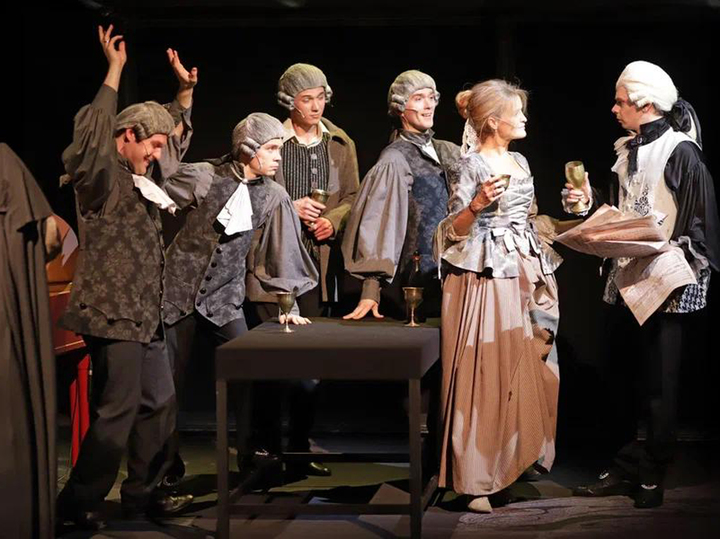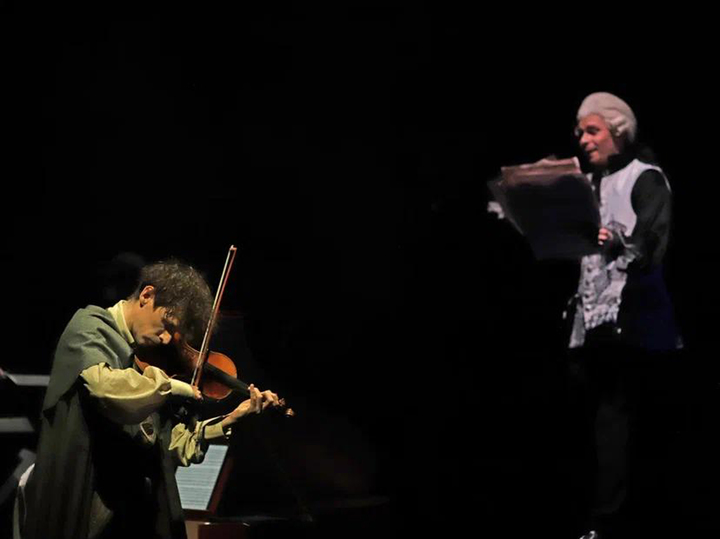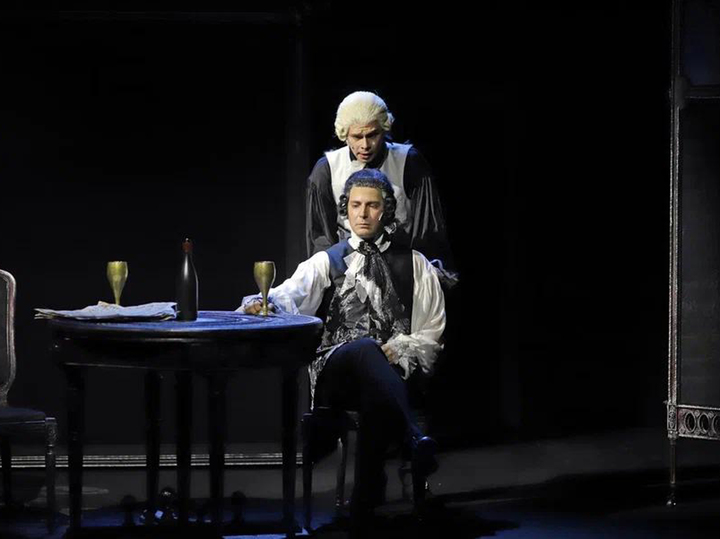Salieri was rehabilitated at the Teresa Durova Theater
[ad_1]
Playwright Artem Abramov added the word “version” to the title of the classic. Some five letters, but Pushkin’s version is called into question. But it all starts with music. And not Mozart, as one might expect, or even Salieri, but an overture from the opera “Vespasian” by Atilio Ariosti, who, by the way, died before both were born. Magical, expressively performed baroque music will anticipate something not magical, but rather criminal – the investigation into the murder of the composer Mozart by the composer Salieri through poisoning. Myth and reality collide in the first part of the performance, which lasts just over an hour. But brevity, as you know, is not only the sister of talent, but also the beginning of a dashing misfortune.
And first there was, as they would say now, a fake about Mozart’s death, committed in 1791 by journalist Georg Sievers (Daniil Islamov). According to the author of the play, it was he who informed his cook Agnieszka (Anastasia Tyukova) that the Estates Theater had received a letter with the news – Mozart had died. “We must write to Berlin, to the Music Weekly. They don’t know there. They’ll publish it there,” the journalist hurries. The commoner, who had never heard of Mozart, assumed that he was poisoned, and only on the basis that the letter said “swelled before death.” “When you poison rats, do you know how they swell from the poison?” So a duck flew into the world – upon returning from Prague, the composer fell ill with dropsy, and “since his body was not examined after death, they even say that he was poisoned. Peace to his ashes.”

The topic of poisoning will continue in the Milan court, where on May 18, 1997, the case “On the defense of the honor of the composer Antonio Salieri” was heard. It is curious that all the names of the participants in the process are real: Paola Accardo (civil prosecutor), Giuliano Spazzali (defender – chairman of the Criminal Chamber of Milan), Vincenzo Salafia (chairman) and, finally, Mario Topolini (court secretary). The essence of the claim: “To whitewash the personality and reputation of the great composer Antonio Salieri, who was unfairly accused of murdering the Austrian composer Wolfgang Amadeus Mozart.” The plaintiffs are confident that this misconception arose thanks to the work of the Russian poet Alexander Pushkin “Mozart and Salieri”.
Lawyer: Russian Signor Pushkin, who is no better than these low sensation hunters, is inflating who knows what from empty rumors! It adds fuel to the fire and certainly cements this construction in the public consciousness: “Salieri poisoned Mozart” (points his hand in the air as a headline). And cements it with the strongest dramatic glue – envy!
It is interesting to follow the detective plot line due to the presented documentary evidence from the life of the genius (including financial and medical), little known to the mass audience. And also due to the rigid structure built by Durova, which does not seem to imply a different style in subsequent scenes. But that’s why it’s a version (translated from Latin as a turn) to surprise. This version, turning sharply, finds itself at the end of the 18th century, where light Mozart (Mikhail Buber), reflective Salieri (Sergei Batov) and… of course, music. Perhaps she is given the palm in the performance. Henry Purcell’s aria, Claudio Monteverdi’s madrigals, brilliantly performed by theater artists and the septet under the direction of Ilya Movchan, are a delight for music lovers.

Before us is a small opera, where, next to a modest-sized stage, there is a small orchestra pit, marked by a side with golden-colored balusters. It must be said that the set design, costumes, and color scheme essentially recreate a small ancient European theater, decorated with great taste. Where the harpsichord sounds, natural, and not recorded (played by Daria Guscha), madrigals and arias are sung. Three colors – purple, silver and gold – create the atmosphere of a performance within a performance, not without intrigue and passion. Two decorative panels (silver on one side, gold on the other), as if under the control of music, silently walk along the backdrop of the stage, now revealing and now hiding a black depth, mysterious and frightening. From which Mozart’s students, a street musician, a mysterious stranger suddenly emerge and disappear. Finally, the genius himself, whom no one considered a genius during his lifetime.
Whether Salieri’s business is favored by the authorities, with positions, honors and salaries, his operas are performed everywhere. And how pleasant he is to everyone, how smart, cunning and courteous… Not like this Mozart, whose behavior was stuck in puberty. And in his music, according to Emperor Joseph II, he has “too many notes.” It is he who should envy Salieri, and not the other way around. But Mozart’s genius will be confirmed by centuries, leaving Salieri the role of a remarkable composer of his time.

And Teresa Durova’s performance is such a musical and picturesque homage to both, and to our Pushkin, with whose light hand, in fact, a small tragedy acquired a timeless scale. Here, it must be said, three “theater sisters” – Teresa Durova, Maria Rybasova and Victoria Sevryukova – created a miracle. Magical, balancing at the turn of the century, between fiction and truth. However, with honest intentions to find the truth, but at the same time giving us the opportunity to shed tears over the fiction.
“You, Mozart, are a god, and you don’t know it yourself.” And then “the strongest dramatic glue” is envy.
Who can say that Salieri was proud?
Someday a despicable envier,
A snake, trampled by people, alive
Sand and dust gnawing helplessly?
Nobody!.. And now – I’ll say it myself – I’m now
Envious…
I feel sorry for both of them.
It sounds like “Requiem, Lacrimosa dies illa, D minor, K.626.” And as it is said in the finale: “You can’t lie to music. Music is a sound presentation of the radiance of a pure soul. And you can weave anything into letters.”
Playwright Artem Abramov told the MK observer about facts and fiction in reading Pushkin’s masterpiece.
“The 1997 trial in Milan turned out to be a huge help for the creation of the play, for the emergence of an effective dramatic counterpoint. We accidentally stumbled upon information about him, studied all the available (and, unfortunately, there are very few) materials, and this made it possible to show the story in a super-voluminous way. Because no one except serious historians, until the moment of that trial, took upon themselves the work of any fundamental rehabilitation of Salieri.
Unfortunately, we did not have access to the court records, and those people with whom we managed to contact – the real participants in the trial, the judge, the prosecutor and the lawyer – no longer really remember how the case happened. Therefore, we had to “think out” the positions of the prosecution and defense and create them anew, taking into account the theatrical specifics. However, we used real, historical texture to the maximum: names, dates, quotes – all this is real. Indeed, there was such a person, journalist Georg Sievers, who was the first to publish a note about Mozart’s death, and in which his own assumption appeared: “Mozart may have been poisoned.” According to today’s laws of journalism, of course, this is blatant unprofessionalism. And, perhaps, “thanks to” this very Sievers, the rumor about the poisoning of Mozart at the hands of Salieri became stronger and began to live its own life.
[ad_2]
Source link






